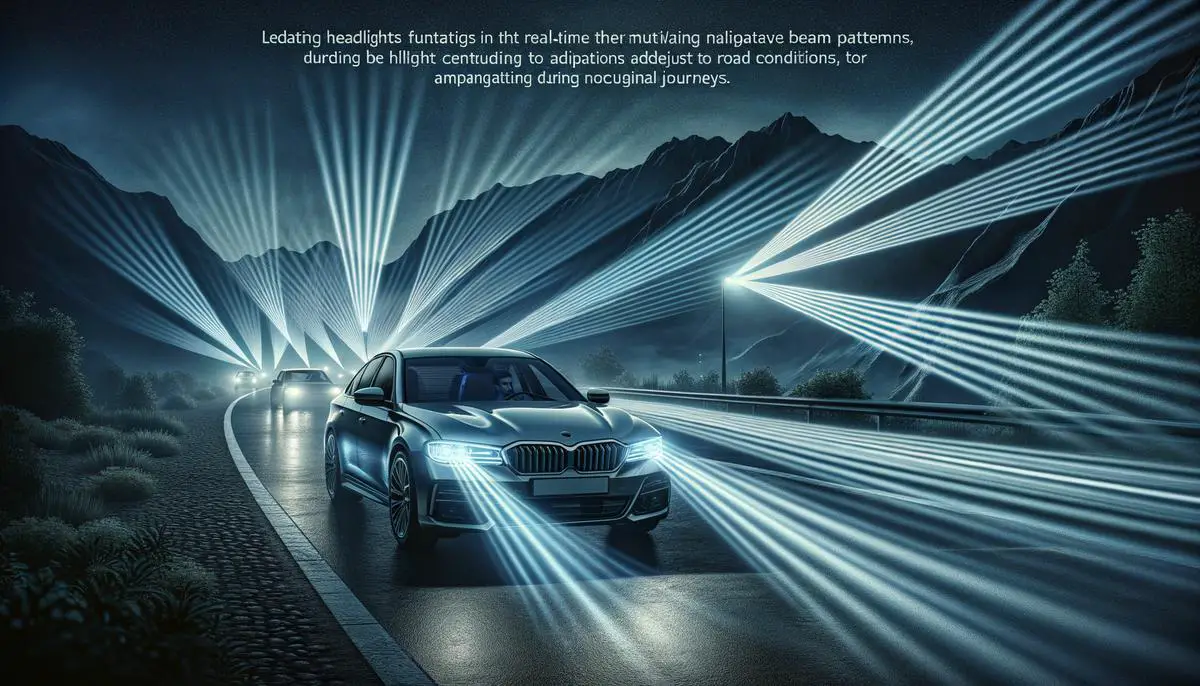Adaptive headlights are transforming the way we see the road at night, offering a blend of technology and safety that promises a brighter future for drivers everywhere. This innovative lighting system adjusts automatically to the road conditions, making night-time driving safer and more comfortable. As we explore the mechanics, benefits, and challenges of adaptive headlights, the significance of this technology in enhancing night driving becomes clear.
Contents
The Technology Behind Adaptive Headlights
Adaptive Headlights: Illuminating the Path for Nighttime Drivers
Driving at night brings its own set of challenges, with limited visibility being at the forefront. Traditional fixed headlights light up the road ahead based strictly on where the vehicle is pointed. Enter adaptive headlights, a game-changer for nighttime driving, designed to make journeys safer by improving visibility around bends and over hills.
Adaptive headlights, as the name suggests, adapt to the driving conditions. When a vehicle equipped with these headlights turns, the headlights swivel in the direction of the turn. This adjustment allows drivers to see more of the road ahead, including potential hazards that would normally be hidden from view with conventional headlights.
These headlights don’t just adjust sideways. Some systems also modify the light beam’s range based on the car’s speed. At higher speeds, the headlights project a longer beam to illuminate distant obstacles sooner, giving the driver more time to react. Conversely, at lower speeds, the light beam is shorter, focusing on illuminating the immediate road ahead more effectively.
Several factors influence the operation of adaptive headlights. The primary inputs include the vehicle’s speed, steering wheel movement, and the yaw rate, which tells the system how much the vehicle is turning in real or relative terms. Using these inputs, the vehicle’s onboard computer calculates the required adjustment to the headlights’ direction and range.
The benefits of adaptive headlights in enhancing nighttime driving safety are supported by various studies. For instance, the Insurance Institute for Highway Safety (IIHS) has found that vehicles equipped with adaptive headlights are involved in fewer accidents, thanks to the improved visibility these systems provide.
However, it’s not just about accident prevention; there’s also a comfort aspect. Driving on winding roads at night with traditional headlights can be stressful, as visibility decreases significantly around bends. Adaptive headlights alleviate this issue, making night-time driving a less daunting task.
In addition to enhancing safety and comfort, adaptive headlights can also contribute to reduced driver fatigue. Better illumination means that drivers can recognize and react to road conditions more easily, reducing the mental strain associated with driving in poor light conditions.
Despite these advantages, adaptive headlights are not yet standard on all vehicles. Cost and regulatory limitations have been barriers to their universal adoption. Nonetheless, as technology advances and becomes more affordable, it’s likely that more vehicles will feature adaptive headlights, further improving nighttime driving conditions.
In conclusion, adaptive headlights represent a significant step forward in automotive safety and comfort. By automatically adjusting the light’s direction and range to match driving conditions, these innovative systems make night-time driving less hazardous and more enjoyable. As adoption increases, the roads may become safer for everyone during the darker hours.

Benefits and Safety Improvements
Understanding the integration of adaptive headlights into mainstream vehicle safety features requires more than just a superficial glance. These advanced illumination systems have garnered attention for their potential in revolutionizing the driving experience under low-light conditions. This part of the article delves into the intricate mechanics behind these lighting marvels and their consequent impact on road safety, sans the jargon and in a language accessible to all.
Adaptive headlights, by design, are smarter than your average vehicle lights. They’re not just about making the road visible; they’re about making it safer. But how exactly do they achieve this? The answer lies in their ability to communicate with the vehicle’s onboard systems. These headlights take input from various sensors that monitor steering wheel movement, the car’s speed, and even its elevation. This data then informs how the headlights will adjust their beam pattern in real-time, ensuring optimal illumination of the road ahead and to the sides.
One of the lesser-discussed but equally crucial features of these headlights is their automatic brightness control. Adaptive headlights can detect oncoming traffic and automatically dim to prevent blinding other drivers—a courteous and safety-enhancing feature. This nuanced approach to illumination reflects a significant leap from the traditional, one-size-fits-all approach of older headlight technologies.
Beyond their technical capabilities, adaptive headlights also contribute to enhancing the aesthetic and value proposition of vehicles. Automakers are increasingly incorporating these lights into newer models as a standard feature, aligning with consumer demand for safer, more advanced vehicles. This trend underscores the shifting priorities in vehicle design towards safety and innovation, making advanced safety features more accessible to a broader audience.
The international landscape for adaptive headlights is evolving, with various regulatory bodies reconsidering restrictions to accommodate these advances. As regulations adjust, the path is cleared for wider adoption, offering the promise of safer roads worldwide. Consumer awareness plays a pivotal role in this transition, with informed buyers more likely to prioritize vehicles equipped with such safety features, thereby influencing market trends and manufacturer priorities.
In summary, while the primary function of headlights remains unchanged— to illuminate the road—adaptive headlights bring a nuanced improvement to this essential vehicle component. By providing dynamic adjustments to lighting based on real-time driving conditions, these headlights not only improve visibility but also significantly contribute to the overall safety of night driving. As technology progresses and consumer preferences evolve, it’s clear that adaptive headlights are set to become a staple in vehicle safety equipment, marking a bright future for road safety.

Current Market and Available Models
Turning our attention toward vehicles equipped with adaptive headlights, this technology has made its way into a broad range of models, from luxury sedans to more accessible family cars. Vehicles featuring adaptive headlights come from various manufacturers who recognize the importance of enhanced night-time visibility and safety.
Luxury vehicle brands have been pioneers in adopting this technology, with BMW offering adaptive headlights across most of its lineup, including the 5 Series and the 7 Series models. These headlights not only adjust the light beam direction based on steering input but also the vehicle’s speed, providing optimal illumination in corners and on highways.
Audi is another key player, incorporating their version, known as the Matrix LED headlights, in models like the Audi A8 and Q7. This innovative lighting system uses advanced technology to deliver precise illumination, adapting to road conditions and other vehicles to prevent glare.
Mercedes-Benz, not to be left behind, integrates adaptive LED headlights in many of its models, including the E-Class and S-Class. These headlamps adjust their brightness and beam pattern dynamically, improving visibility without dazzling other road users.
Beyond the luxury segment, more affordable car brands have also started to embrace adaptive headlights. The Mazda CX-5, for example, offers the Adaptive Front-lighting System as part of its I-ACTIVSENSE safety features, aiming to enhance visibility on winding roads.
Ford has made strides in this area too, with its adaptive front lighting system available in models like the Ford Explorer and Mustang. These headlights adjust their patterns based on speed, steering angle, and even ambient light conditions, making night driving safer.
The Toyota Prius and the Volkswagen Golf are examples from brands that have introduced adaptive headlights to a wider audience, integrating them into vehicles known for their efficiency and reliability. These features show a commitment to safety that extends across different market segments.
Korean automotive manufacturers Hyundai and Kia have also adopted this technology. Vehicles like the Hyundai Sonata and the Kia Sorento feature adaptive headlights that adjust the light distribution based on how the vehicle is being driven, reflecting a broader industry trend towards prioritizing driver and pedestrian safety through innovative lighting.
As the automotive industry continues to evolve, the adoption of adaptive headlights is becoming more widespread, moving beyond luxury vehicles and into the mainstream. This trend underscores the growing importance of advanced safety features in modern vehicles, with manufacturers across the board investing in technologies that make driving at night safer and more comfortable for everyone on the road.

Challenges and Limitations
Despite the clear advantages and innovative progress of adaptive headlight technology, the path to its widespread integration into vehicles of all categories faces several notable obstacles. Understanding these challenges requires a closer look at the broader context within which adaptive headlights must evolve.
One significant hurdle is the global disparity in regulatory acceptance. Despite their potential to enhance nighttime driving safety, adaptive headlights must traverse a labyrinth of international vehicle regulations. Different countries and regions maintain distinct standards for vehicular systems, making it cumbersome for manufacturers to design a one-size-fits-all solution. This fragmentation in regulatory landscapes can slow down the deployment of adaptive headlights across global markets, as manufacturers navigate the complex process of certification in multiple jurisdictions.
Additionally, the technical complexity and cost of implementing adaptive headlight systems pose another barrier. The sophisticated technology behind adaptive headlights, which includes sensors, cameras, and computer-controlled mechanisms to adjust the light beam, adds to the manufacturing cost of a vehicle. This could hinder their incorporation into budget and mid-range car segments, where price sensitivity is a significant factor for consumers. While the technology is becoming more common in luxury vehicles, its penetration into more affordable models is crucial for achieving widespread adoption and the associated safety benefits.
The integration of adaptive headlights with a vehicle’s existing systems also presents a technical challenge. Vehicles are now more connected and complex than ever, with numerous onboard systems that need to communicate seamlessly. Ensuring the adaptive headlight system works in harmony with other vehicle safety features, such as lane-keeping assist or autonomous driving capabilities, requires careful design and integration. This complexity not only impacts the cost but also the feasibility of retrofitting existing models with adaptive lighting systems, limiting the technology’s availability to newer models.
Consumer education and awareness play a crucial role in the adoption of any new technology, and adaptive headlights are no exception. Many drivers may not fully understand the benefits or operation of adaptive headlights, potentially reducing demand. Automotive manufacturers and safety organizations need to invest in educational campaigns that highlight how these headlights work and their advantages for nighttime driving safety. Without a clear consumer demand signal, the push towards standardizing adaptive headlights across the automotive industry may lack the momentum needed for rapid adoption.
Lastly, the durability and maintenance of adaptive headlight systems could be a concern for both consumers and manufacturers. Given the advanced technology involved, potential failures or malfunctions could lead to higher repair costs and maintenance challenges. Ensuring these systems are robust and easily serviceable will be critical for both consumer acceptance and long-term viability.
In summary, while adaptive headlight technology promises to revolutionize nighttime driving safety, its path forward is riddled with regulatory, technical, and market-based hurdles. Overcoming these challenges will require concerted efforts from automotive manufacturers, regulators, and safety organizations to ensure that the benefits of adaptive headlights can be fully realized and accessed by drivers around the world.

As adaptive headlights continue to illuminate the paths of countless vehicles around the globe, their impact on night-time driving safety and comfort is undeniable. Through the collaborative efforts of manufacturers, regulators, and consumers, the road ahead looks promising, with these intelligent lighting systems leading the way. Embracing adaptive headlights not only elevates the driving experience but also marks a significant step towards a future where advanced technology and safety go hand in hand, ensuring the well-being of everyone on the road, night after night.



